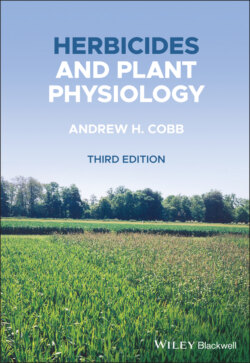Читать книгу Herbicides and Plant Physiology - Andrew H. Cobb - Страница 42
1.9.3.4 Conservation agriculture
ОглавлениеConservation agriculture (CA) is a system that avoids or minimises soil disturbance, combined with soil cover and crop diversification. It is considered to be a sustainable agro‐ecological approach to conserving resources in agricultural production. A major challenge to CA is weed management without the use of herbicides.
The review paper by Sims et al. (2018) lists and evaluates options for ecological and integrated weed management in CA to prevent weed pressure from building. The choice of methodology will depend on what technical options are locally available and the prevailing economic environment. A summary of methods is presented below:
1 Quality seed and clean equipment: use proven quality seed and clean machinery to avoid or lessen weed seed introduction from the external environment.
2 Reduce the weed seed bank: to deplete the weed seed bank, seed set should be avoided wherever possible. Reduced tillage and cover crops can favour weed seed predation, especially by insects and birds. ‘Beetle banks’ are strips of natural vegetation and grasses that provide a haven for seed eaters and can also prevent potential soil erosion if established to follow the contours of the land. Increased germination by minimal soil disturbance followed by mechanical or chemical control may eliminate weed flushes prior to crop establishment. Prevention of the shedding of weed seeds at cereal crop harvest can be achieved by mechanical means. ‘Chaff Carts’ are trailers attached to the rear of the harvester to collect chaff and weed seeds, which are the collected for disposal, or for animal feed. A ‘weed seed mill’ can also be trailed behind the combine and contains a mill that pulverises the chaff and weed seeds. The resultant mixture may be returned to the field as nutrients. ‘Weed headers’ remove weed flowers growing above crop height before the seed heads appear. In this case, horizontal rotors fitted with blades are attached to a tractor. This method has proven effective in low‐growing crops, such as sugar beet.
3 Crop rotation: this is a very effective cultural approach to weed management. It prevents the proliferation of weed populations that can become dominant in monocultures. Rotations of annual, biennial and perennial crops are effective, as is the inclusion of leguminous crops, which also offers a positive nitrogen input. The inclusion of crops with allelopathic properties to inhibit weed growth has also been reported. In addition, mulching can provide soil cover that prevents light from reaching the soil surface, and so reduces or inhibits weed seed germination.
Sustainable weed seed management therefore consists of a range of alternative options to herbicide use that can prevent or lessen weed seed proliferation, rather than to control them when they interfere with crop growth and development. Finally, farmers and growers are now under increased pressure to reduce agrochemical inputs, yet they struggle with the need to control herbicide‐resistant weeds. We may expect new weed control technologies to emerge in the coming decades, such as robots that scan the growing crop, with directed lasers to control weeds.
